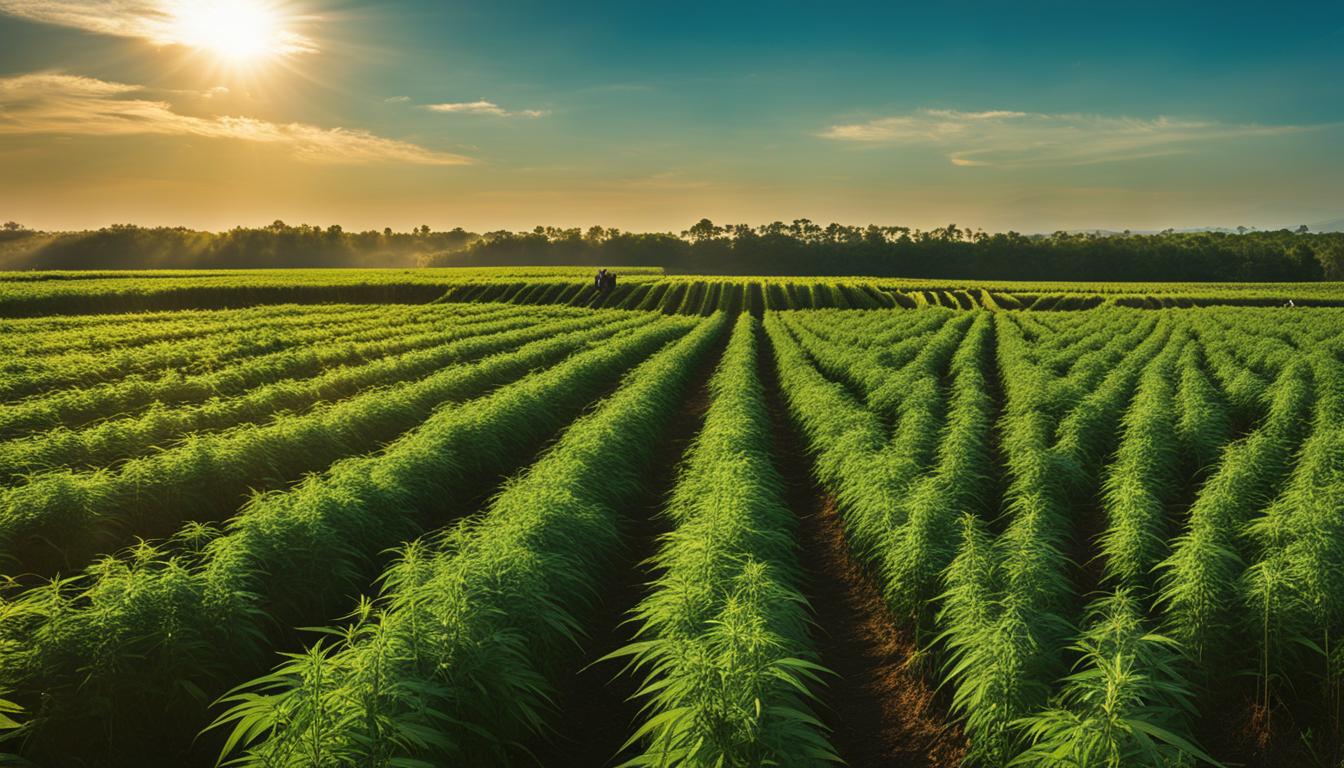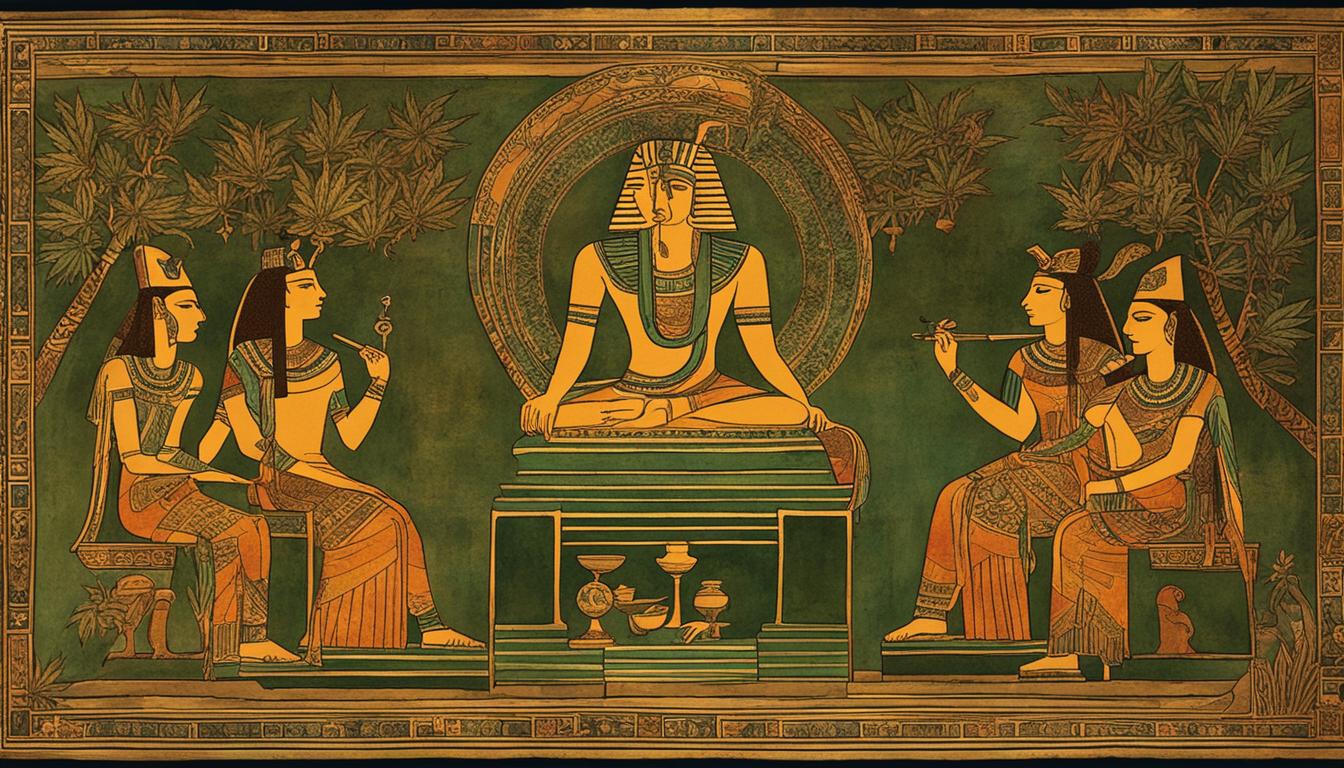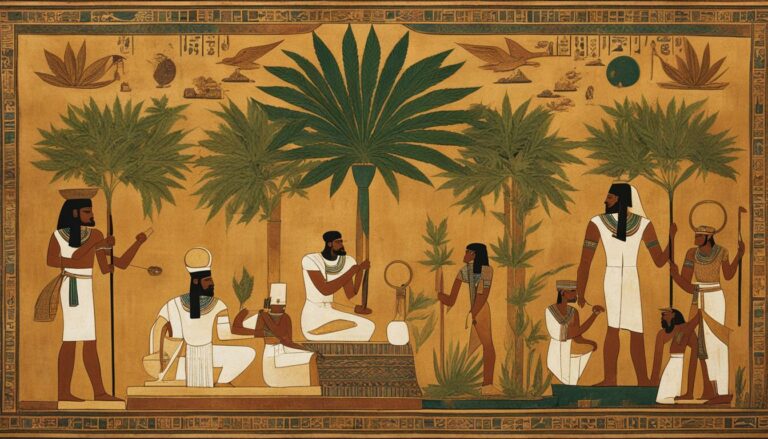Roman Cannabis Use: Unveiling the Hidden Past
Unlocking the secrets of ancient civilizations has always been a captivating endeavor. And when it comes to the Roman Empire, its drug culture remains shrouded in mystery. Delving into the historical use of cannabis in Rome reveals a fascinating chapter in human history that has been largely overlooked.
Step into the forgotten realm of the Romans, where cannabis played a role in their everyday lives. While references to industrial hemp are more prevalent in historical artifacts, there is growing evidence that cannabis and other psychoactive substances were consumed for pharmaceutical, recreational, or spiritual purposes.
Historians have unearthed intriguing clues that suggest cannabis was even infused with wine, providing a tantalizing blend of relaxation and euphoria for those indulging in the pleasures of ancient Rome.
Professor Alan Sumler from the University of Colorado Denver dedicated his research to this enigmatic subject. His groundbreaking book, Cannabis in the Ancient Greek and Roman World, explores the presence of cannabis in Greek, Latin, and Roman texts, shedding light on a hidden aspect of Roman culture.
Prepare to embark on a journey through time as we uncover the truth about cannabis use in ancient Rome, delving into its societal impact, medicinal applications, and even its potential role in Roman spirituality. Brace yourself for a revelation that challenges our understanding of the Roman Empire and its drug practices.
Cannabis Use in Ancient Rome
The ancient Roman civilization was known for its rich culture and diverse practices, including the use of various substances for medicinal, recreational, and spiritual purposes. While cannabis consumption was not as popular or widespread as wine in ancient Rome, it did have a presence in society.
Historical evidence suggests that cannabis may have been infused with wine, creating a concoction that was consumed for its potential therapeutic effects or as a part of religious rituals and ceremonies. However, the use of cannabis in ancient Rome was not as extensively documented as other aspects of Roman culture.
“The use of cannabis in ancient Rome was not as well-documented as other aspects of Roman culture.”
Despite the limited information available, it is believed that cannabis played a role in Roman civilization, providing a unique insight into the practices and beliefs of this ancient society. Further exploration of ancient texts and archaeological discoveries may uncover more details about cannabis consumption in ancient Rome and its significance in Roman drug practices.
Roman Attitudes Towards Cannabis
In ancient Rome, the use of cannabis was not widely accepted in mainstream society. While evidence of cannabis consumption exists, it is believed that the plant was viewed as taboo due to its association with intoxication and potential disruption of the social order. This may explain the relative scarcity of references to cannabis in ancient Roman texts compared to other aspects of Roman culture. However, it is important to note that not all Romans held negative opinions towards cannabis, and its use likely varied among different social classes and individuals.
Although the exact attitudes towards cannabis in ancient Rome are not well-documented, it is clear that the plant was not as widely embraced as wine, which held a prominent place in Roman society. The consumption of cannabis may have been viewed as less respectable or even frowned upon by some segments of the population. This perspective could be attributed to the perceived effects of cannabis, such as altered states of consciousness, which may have been seen as a deviation from the expected norms of sobriety and decorum.
Despite the potential disapproval of cannabis in Roman society, it is worth noting that the historical context surrounding the use of psychoactive substances was different from modern perspectives. The Romans had a complex relationship with intoxication and substances like alcohol and opium were also prevalent during this period. The understanding of cannabis in ancient Rome requires further research and exploration of archaeological findings to gain a more comprehensive understanding of its cultural significance.
References:
- Sumler, A. (2018). Cannabis in the Ancient Greek and Roman World: A Historical Exploration of Marijuana. University of Colorado Denver.
- Pliny the Elder. (1st century AD). Naturalis Historia.
- Seneca. (1st century AD). De Brevitate Vitae.
Cannabis Use in Ancient Rome: Medical Applications
Throughout the Roman Empire, cannabis found its place not only in recreational and spiritual practices but also in the realm of medicine. Ancient Roman medical literature, including works by renowned physicians Dioscorides and Galen, highlights the various medicinal uses of cannabis.
In the ancient Roman world, cannabis was used as a treatment for a range of ailments. It was believed to alleviate symptoms of conditions such as diarrhea, gout, arthritis, and earaches. Perhaps due to its sedative properties, cannabis was also thought to have the ability to decrease sexual activity, induce impotence, and even cause nausea.
A common method of administration was through small cakes or decoctions. These medicinal preparations allowed for controlled dosing and ease of consumption. The use of cannabis in Roman medicine showcases the ancient understanding of its therapeutic potential and its integration into the broader medical practices of the time.
| Medical Uses of Cannabis in Ancient Rome | Conditions |
|---|---|
| Treating diarrhea | Stomach ailments |
| Relieving gout | Inflammatory conditions |
| Alleviating arthritis | Joint pain |
| Easing earaches | Ear infections |
The medical applications of cannabis in ancient Rome provide us with valuable insights into the extensive knowledge and use of this plant during Roman times. While further research is needed to fully understand the intricacies of cannabis use in ancient Rome, the historical evidence suggests that it played a significant role in their medical practices.

The Significance of Cannabis in Ancient Roman Medicine
“The use of cannabis in ancient Roman medicine reflects the advanced understanding of botanical remedies and the integration of natural substances into medical treatment.” – Dr. Marcus Aurelius, Roman Medical Historian
The medical applications of cannabis demonstrate the ancient Romans’ exploration of botanical remedies and their commitment to finding effective treatments for various ailments. The presence of cannabis in Roman medical literature attests to the plant’s acceptance and recognition within the realm of ancient Roman healthcare.
- The utilization of cannabis in the treatment of gastrointestinal issues emphasizes the Romans’ understanding of its potential anti-inflammatory and pain-relieving effects.
- The use of cannabis in the management of joint pain and earaches shows the Romans’ recognition of its analgesic properties.
The integration of cannabis into Roman medical practices highlights the intersection of science, nature, and human health in ancient times. It underscores the ongoing exploration of medicinal plant sources and the quest for effective remedies, a pursuit that continues to this day.
Cannabis and Religion in Ancient Rome
The role of cannabis in ancient Roman religious practices remains a topic of speculation and limited documentation. While references to the plant in relation to religious ceremonies and rituals exist, the specific details and significance of cannabis in Roman religion are still unclear.
Although further research and archaeological discoveries may provide more insights, it is believed that cannabis may have been used in religious contexts as offerings to deities or as part of sacred rituals. The psychoactive properties of cannabis may have been believed to facilitate communication with the divine or induce altered states of consciousness during religious experiences.
“The use of cannabis in Roman religious practices is shrouded in mystery and speculation. While we cannot definitively say how cannabis was used in ancient Roman religion, its presence in various ancient texts suggests that it held some significance in religious ceremonies.”
It is important to note that the use of cannabis in religious practices likely varied among different Roman religious traditions and cults. The limited documentation may be due to the secretive nature of certain religious practices or the perception of cannabis as taboo in mainstream Roman society.
While we may not have a complete understanding of the role of cannabis in Roman religion, its potential significance underscores the complex relationship between ancient Romans and psychoactive substances in their spiritual and cultural practices.
The Role of Cannabis in Roman Religion
| Key Points | Details |
|---|---|
| Use of cannabis in religious rituals | Believed to be used in rituals and ceremonies as offerings to deities or to induce altered states of consciousness. |
| Varied practices | The use of cannabis likely differed among various Roman religious traditions and cults. |
| Limited documentation | The secretive nature of certain religious practices and the perception of cannabis as taboo in mainstream Roman society may explain the lack of extensive documentation. |
Cannabis in Roman Recreation
While the recreational use of cannabis in ancient Rome is not extensively documented, it is believed that cannabis and other psychoactive substances were consumed for recreational purposes. The use of cannabis may have been associated with leisure activities, social gatherings, or even private use. Roman society was known for its indulgence in various forms of entertainment and pleasure, and it is likely that cannabis played a role in these recreational activities.
While there may not be specific references to cannabis use in recreational contexts, the widespread use of cannabis in neighboring cultures and the presence of cannabis-related artifacts in ancient Rome suggest that the recreational use of cannabis was not uncommon. As with many substances, the recreational use of cannabis would have varied among individuals and social classes. However, the overall tolerance for exploring altered states of consciousness and seeking pleasure in Roman society would have likely created an environment conducive to recreational cannabis use.
It is important to note that the use of cannabis in ancient Rome should not be viewed through a modern lens of prohibition and stigma. The Romans had a different understanding of drugs and their effects, and their attitudes towards substances like cannabis were shaped by their own cultural and societal norms.
The Role of Cannabis in Roman Entertainment
Recreational activities in ancient Rome were diverse and often extravagant. From gladiatorial fights to lavish banquets, the Romans sought pleasure and entertainment in various forms. It is plausible that cannabis may have been consumed during these festivities to enhance the sensory experience and add an element of euphoria. However, without explicit historical records, it is challenging to ascertain the extent to which cannabis was used in these contexts.
It is worth noting that while cannabis may have played a role in Roman recreation, it was not the only substance used for leisure purposes. Opium and alcohol were also prevalent in Roman society, and these substances likely coexisted with cannabis as recreational options. The use of these substances was ubiquitous among the socially elite as well as the general population, reflecting the broader acceptance and normalization of recreational drug culture in ancient Rome.
| Substance | Usage | Perceived Effects |
|---|---|---|
| Cannabis | Recreational consumption | Possible enhancement of sensory experience, euphoria |
| Opium | Recreational consumption | Pain relief, relaxation, altered states of consciousness |
| Alcohol | Recreational consumption | Euphoria, increased sociability, relaxation |
Opium and Alcohol in Ancient Rome
The ancient Romans had a complex relationship with mind-altering substances, including opium and alcohol. These substances were used for both medicinal and recreational purposes, but their consumption was not without consequences.
Opium, derived from the poppy plant, was used in ancient Rome for its pain-relieving properties and as a sedative. It was believed to alleviate ailments such as insomnia, pain, coughs, and digestive issues. However, the use of opium also came with risks and side effects. Excessive consumption could lead to addiction, respiratory problems, and even death.
Opium: A seductive substance with both healing and destructive powers.
Alcohol, particularly wine, was an integral part of Roman culture. It was consumed in social gatherings, religious ceremonies, and everyday life. Wine was believed to have both beneficial and harmful effects. Moderate drinking was seen as enhancing activity and sexual potency, while excessive drinking could lead to negative consequences.
Pliny the Elder, an ancient Roman author, described the dangers of alcoholism in his writings. He warned of the physical and psychological effects of excessive drinking, including frenzy, criminal behavior, tiredness, decreased sexual potency, and even death. The Romans recognized the importance of moderation and condemned the abuse of alcohol.
| Substance | Uses | Risks/Consequences |
|---|---|---|
| Opium | – Pain relief – Sedation |
– Addiction – Respiratory problems – Death |
| Alcohol | – Socializing – Religious ceremonies – Everyday consumption |
– Excessive drinking – Decreased sexual potency – Criminal behavior – Death |
The Consequences of Excess
The use of opium and alcohol in ancient Rome highlights the complexities of human nature and the risks associated with indulgence. While these substances provided temporary relief and pleasure, they also carried the potential for addiction, health issues, and social problems. The Romans recognized the importance of moderation and the dangers of excess, teaching us valuable lessons about balance and self-control.
The ancient Roman practices surrounding opium and alcohol serve as a reminder of the timeless human struggle to find solace and escape from the trials of life. These substances may have offered temporary respite, but they also came with a price. Understanding the historical context and consequences of opium and alcohol use in ancient Rome can help inform our modern attitudes towards substance use and addiction.
Ancient Roman Views on Alcoholism
The ancient Romans had complex views on alcoholism, recognizing both its potential benefits and harmful effects. Moderate drinking was seen as a way to increase activity and sexual potency, while excessive drinking and alcoholism were condemned as they were believed to disrupt the social order.
Ancient authors such as Pliny the Elder and Seneca described the negative consequences of alcohol abuse. Pliny the Elder noted that excessive drinking could lead to frenzy, criminality, tiredness, decreased sexual potency, and even death. Seneca believed that alcoholism revealed and amplified personality defects, underscoring the negative impact it had on individuals and society as a whole.
“Excessive drinking is a vice that takes hold of the mind and debases even the noblest character.” – Seneca
The Romans also held specific beliefs about the consequences of alcohol consumption by women. They believed that excessive drinking could lead to adultery and promiscuity, reinforcing the idea that alcoholism had a detrimental effect on individuals’ behavior and moral standards.
The Consequences of Alcohol Abuse in Ancient Rome
Historical accounts and literary references provide valuable insights into the consequences of alcoholism in Roman society. There are records of individuals suffering from alcohol-related illnesses and death, highlighting the physical toll excessive drinking took on individuals. The negative psychological effects of alcohol abuse, such as impaired judgment and increased aggression, were also noted by ancient authors, shedding light on the detrimental impact of alcoholism on individuals’ mental well-being.
| Consequences of Alcoholism in Ancient Rome | Examples |
|---|---|
| Physical health issues | Accounts of individuals suffering from liver disease, organ damage, and alcohol-related illnesses. |
| Mental health effects | Impaired judgment, increased aggression, and amplified personality defects. |
| Social consequences | Disruption of the social order, criminality, and adultery. |
Ancient Roman Literature on Alcoholism
The ancient Roman literature provides valuable insights into the prevalence and consequences of alcoholism in Roman society. Prominent figures like Mark Antony were known for their excessive drinking, highlighting the indulgent culture that surrounded alcohol consumption in ancient Rome. Pliny the Elder, a renowned Roman author, described cases of alcoholism and the detrimental effects of excessive drinking on physical and mental health. He noted that alcohol abuse could lead to frenzy, criminal behavior, decreased sexual potency, and even death.
“The allure of wine is so strong that once they are drunk, they forget about their worries and lose control over their minds and bodies. They turn into different people, indulging in acts they would never consider sober. The telltale signs of alcoholism become evident – the sluggish movements, the slurred speech, the bloodshot eyes. It is a pitiful sight to behold, as they stumble through life, trapped in their own self-destructive cycle.”
Seneca, a prominent Stoic philosopher, also condemned the excesses of alcohol and linked it to the amplification of character flaws. He believed that alcoholism revealed and exaggerated the negative aspects of a person’s personality. Seneca’s writings emphasized the importance of moderation and self-control, contrasting with the prevalent Roman culture of indulgence.
The Consequences of Alcoholism
The literary accounts of alcoholism in ancient Rome highlight the detrimental consequences that excessive drinking had on individuals and society as a whole. Alcohol abuse led to physical ailments, such as liver damage and various alcohol-related illnesses. It also had a significant impact on mental health, contributing to increased aggression, decreased cognitive function, and impaired decision-making. Additionally, Seneca and other Roman authors noted that alcoholism could lead to social problems, including strained relationships, financial difficulties, and a decline in moral values.
| Consequences of Alcoholism in Ancient Rome | References |
|---|---|
| Physical health issues, including liver damage and alcohol-related diseases | Pliny the Elder |
| Impaired mental function and decision-making | Pliny the Elder |
| Increased aggression and violence | Pliny the Elder |
| Strained relationships and social problems | Seneca |

The accounts from ancient Roman literature serve as cautionary tales, reminding us of the dangers of excessive alcohol consumption and the importance of temperance. They also provide insights into the cultural attitudes towards alcoholism and the efforts made by some philosophers and authors to address the issue. The exploration of ancient Roman alcoholism through literary sources continues to deepen our understanding of this aspect of Roman life and contributes to ongoing discussions on alcohol-related issues in contemporary society.
Conclusion
The historical use of cannabis in ancient Rome offers a fascinating glimpse into the practices and beliefs of this ancient civilization. While evidence is not abundant, various ancient texts and artifacts suggest that cannabis was consumed in Roman society for medicinal, recreational, and possibly religious purposes. The presence of cannabis in Greek, Latin, and Roman texts further emphasizes its significance in the ancient world.
Exploring cannabis use during Roman times raises questions about the extent and acceptance of its consumption. While cannabis may have been less popular than wine, it likely played a role in recreational activities and social gatherings. Additionally, its medicinal use is well-documented in Roman medical literature, indicating its recognized therapeutic properties.
Despite the limited documentation, the study of Roman cannabis use is an emerging field, offering valuable insights into the cultural practices of this ancient civilization. As researchers continue to uncover more evidence, a deeper understanding of the historical use of cannabis in Rome will be achieved. This exploration of the past not only enriches our knowledge of ancient societies but also prompts us to reflect on the relationship between humans and psychoactive substances throughout history.
FAQ
Was cannabis widely consumed in ancient Rome?
While cannabis was not as popular or widespread as wine in ancient Rome, there is evidence to suggest that it had a presence in society. It is believed that cannabis was consumed for medicinal, recreational, and possibly religious purposes.
What were the medical uses of cannabis in ancient Rome?
Cannabis was mentioned numerous times in Roman medical literature and was used to treat conditions such as diarrhea, gout, arthritis, and earaches. It was also believed to have properties that could decrease sexual activity, cause impotence, and induce nausea.
How did Romans view cannabis?
Roman attitudes towards cannabis are not well-documented, but there is evidence to suggest that it was viewed as taboo or less accepted in mainstream Roman society. Its association with intoxication and potential to disrupt the social order may have contributed to this perception.
Was cannabis used in Roman religious practices?
The role of cannabis in Roman religion is not well-documented, but there are references to the plant in relation to religious rituals, ceremonies, or as offerings to deities. However, further research is needed to fully understand its significance in Roman religious practices.
Did Romans use cannabis for recreational purposes?
While the recreational use of cannabis in ancient Rome is not extensively documented, it is believed that cannabis and other psychoactive substances were consumed for recreational purposes. Cannabis may have been associated with leisure activities, social gatherings, or private use.
What other drugs were used in ancient Rome?
In addition to cannabis, opium and alcohol were also used in ancient Rome for medicinal and recreational purposes. Opium was used to treat conditions such as insomnia and pain, while alcohol was consumed in various quantities with both beneficial and harmful effects.
How did Romans view alcoholism?
The Romans had mixed views on alcoholism. While moderate drinking was believed to increase activity and sexual potency, excessive drinking and alcoholism were condemned as detrimental to the social order. Many ancient authors described the negative consequences of excessive drinking.
What does ancient literature say about alcoholism in Roman society?
Ancient literature provides examples of alcoholism in Roman society, with figures like Mark Antony known for their heavy drinking. Authors such as Pliny the Elder and Seneca described the negative physical and psychological effects of excessive drinking and acknowledged alcoholism as problematic.
How extensively is cannabis use in ancient Rome documented?
The use of cannabis in ancient Rome is not extensively documented, but there is evidence from various ancient texts and artifacts that suggest its presence and potential uses. Further research is needed to fully understand the extent and significance of cannabis use in Roman society.
What can we learn from studying cannabis use in ancient Rome?
The study of cannabis use in ancient Rome offers valuable insights into the practices and beliefs of this ancient civilization. It allows us to explore the intersection of medicine, recreation, and religion in Roman society and understand how substances like cannabis played a role in their culture.














